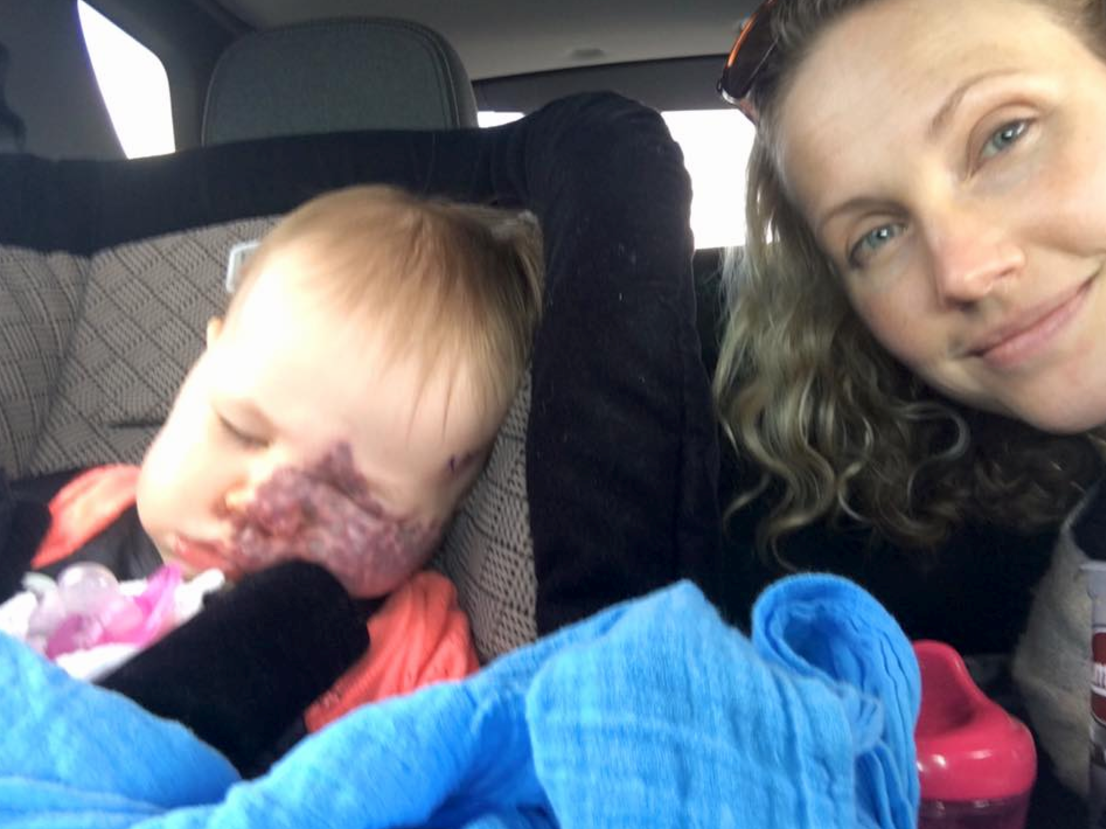A newscaster in Iowa has posted a photo of her 14-month-old daughter to Facebook detailing the treatment she is undergoing for a facial port-wine stain.

WATCH BELOW: Sick kids doctors save eye of boy, 3, with rare cancer
Elizabeth Klinge, who is a news anchor with KCCI Des Moines, shared a snap with her daughter, Hanalay, following her fourth laser treatment to treat her prominent birthmark.
The triptych of photos shows Hanalay asleep after her treatment, but over the course of the same car ride, she seems to wake and perk up. Her port-wine stain is also deeply coloured, which Klinge said in a newscast is a result of her treatment, “but that just means the treatment worked.”
Response to the post was swift, and overwhelmingly sympathetic and encouraging. Since it appeared on Sept. 6., it has received over 2,200 likes and more than 200 comments.
READ MORE: ‘Napalm girl’ undergoing laser treatments to ease pain, decades later
“Thank-you for sharing these pictures,” Facebook user Nancy Jensen wrote. “A happy little trooper just like mom. Glad there are treatments but it breaks my heart thinking this little one as to go through all this.”
“What a cute little girl! Starting at 6 months of age, my daughter had 9 laser treatments on her port wine stain,” wrote Susie Colen Braverman, “it was on her right eyelid and forehead. It was so hard to put her through that. I know exactly what you’re going through. Hang in there.”
What is a port-wine stain?
Also known as a vascular birthmark, a port-wine stain is an abnormal, genetically-determined growth of blood vessels that occurs in roughly one in 20,000 children.
“It’s a proliferation of blood vessels that look like spider veins gone crazy,” Dr. Stephen Mulholland, owner and medical director of SpaMedica in Toronto, said to Global News. “On babies, port-wine stains are flat and pink, but if untreated, over time they get larger, lumpy and the skin thickens.”
They can appear anywhere on the body, although they are most commonly found on the face, neck, scalp, arms or legs. They happen in-utero and cannot be prevented, nor are they a result of anything the mother did during pregnancy.
In very rare cases, a port-wine stain can be an indication of Sturge-Weber syndrome, a condition that affects the brain and can result in seizures, eye problems, weak muscles, migraines and learning difficulties.
How do you treat port-wine stains?
In the past, port-wine stains were treated with skin grafts that were painful and could cause scarring. But now, patients are treated via Pulsed Dye Laser (PDL), which targets the hemoglobin inside the blood vessels in the stain. The laser heats up the blood vessel and damages it, thus killing the stain from the inside-out.
“We’re lucky nowadays because we have high-tech lasers that treat port-wine stains without the scarring of skin grafting,” Mulholland said. “There’s no blistering or oozing. The area will look bruised for 10 days to two weeks, but it gets lighter over time.”
He says it takes anywhere from six to 16 treatments, which are spaced out every two months, and it will result in a 90 per cent reduction or better. Sometimes, the area treated will end up looking lighter than the rest of the skin, a condition called hypopigmentation, but Mulholland points out, that’s much easier to camouflage than the port-wine stain.
READ MORE: How to talk to kids about weight — without fat-shaming them
“The treatment is totally safe for kids, although it can be a bit painful. We usually use a topical anaesthetic, and the laser has a cryogen spray that hits the skin a split second before the laser to help cool the area.”
He says that in Canada, provincial healthcare doesn’t always cover the costs of PDL, but many surgeons will treat children under four free of charge.




Comments